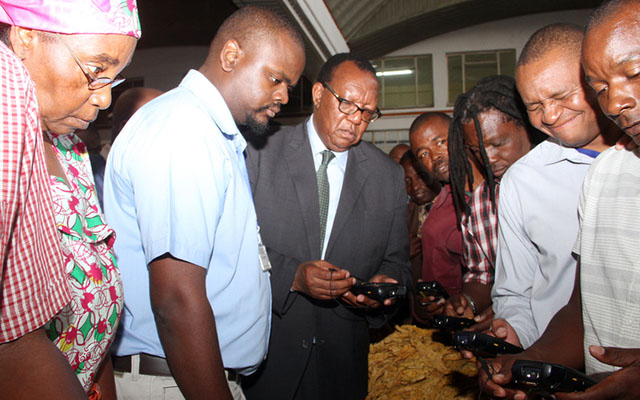
Agriculture, Mechanisation and Irrigation Development Minister Dr Joseph Made (centre) joins in the bidding for tobacco with buyers using the new e-marketing system during the official opening of the tobacco selling season last week while TIMB board chair Monica Chinamasa (left) and official Tinashe Dhliwayo (second from left) look on. – Picture by Justin Mutenda
Obert Chifamba Agri-Insight
The 2017 tobacco marketing season started last Wednesday. And the major highlight of the day was the $4,60 per kilogramme price that was offered for the golden leaf at the auction floors.
This time around there were no protests over prices and things seem to have started on a good note.
Farmers and other concerned stakeholders like Government felt the price was not bad after all since the bulk of the tobacco delivered on this day comprises first primings from the lower leaves.
Expectations are, however, high that the prices must continue to firm as the best grade of the leaf will be coming as the season progresses.
The Reserve Bank of Zimbabwe (RBZ) had also added to the farmers’ delight by announcing that they would be allowed to withdraw cash of up to $1 000 for their first sales and $500 for their subsequent sales but this seems to be just a dream silhouetted against the horizon.
Just a few days after the opening of the floors police had to be called in to quell protests by the farmers at the Tobacco Sales Floor after they failed to access the promised $1 000, as banks were instead offering just $300.
The RBZ move, of course, had been done in light of the ongoing cash shortages rocking the country.
Last year the same farmers were accorded corporate status by RBZ, which allowed them to make withdrawals of up to $10 000 but this again never materialised, as the highest amount the farmers reportedly managed to access was $3 000.
Maybe for the RBZ, the spirit is there and willing but the implementation by banks is absent.
Also, the 5 percent export incentive for the current season would be credited to the farmers’ bank accounts at the end of every month, the RBZ revealed.
The glee of the opening day aside, I have noticed a trend that got me thinking. In 2012, the opening day price was $4,45, then it was $4,89 for 2013, $4,85 in 2014 with 2015 recording a significant dip to $3,50 before it shot back to $4,50 in 2016.
There is not a season in recent memory where the first day has managed to break the $5 per kilogramme ceiling.
The obvious question is why is this so? Initially, we all thought tobacco was a new crop to most farmers so they were still struggling to match the quality requirements by the merchants but with more years of producing it, even the quality of the lower leaf is bound to improve and ultimately the price too.
This see-saw kind of pricing, to me may be designed to deflate the confidence of producers and prepare them for low prices in the course of the marketing season.
We have noticed that over the years the highest price fetched at the auction floors has been $4,99 while the contract side has even given prices as high as $6,20 per kilogramme.
In 2015 there were chaotic scenes at the floors as farmers rejected the meagre $3,50 per kilogramme fetched as the highest price on the opening day of the season and it seems to placate them the following season, the price rose to $4,50, which naturally did not incense the farmers.
This time around merchants just added $0,10 to last season’s price and it did the trick again.
I am sure merchants may also be celebrating the hiccup that saw the much-hyped e-marketing system that Tobacco Industry and Marketing Board (TIMB) had adopted failing to take off, as it was widely billed to be the solution to curbing collusion among buyers on pricing matters.
Yes, the old manual method has since been given another lease of life and so the alleged complicity among buyers is also most likely to be re-gaining a new lease of life after the brief e-marketing system scare.
Merchants have come up with a plethora of reasons for degrading farmers’ tobacco and have ended up getting the product for a song only to sell it later at very high prices.
There have even been reports of buyers going out into the farming communities taking advantage of transport and other logistical problems farmers face to buy the golden leaf at very unviable prices only to sell it at very good grades for correspondingly very good prices.
The farmer has always been coming out with the worse bruised ego every marketing season.
One very interesting observation is that contract buyers have over the years been known to offer better prices yet there is virtually nothing different between the tobacco contracted farmers and the non-contracted ones deliver at the floors.
Maybe the quality of tobacco improves once a farmer produces it under contract.
Most of the farmers taking the contract option are those making their debut in the industry and do not have adequate resources to produce independently while those doing in on their own normally have the capacity to do so and have years of experience on their side to produce quality leaves. The matrix is just tricky, if you know what I mean.
- Feedback: [email protected].
